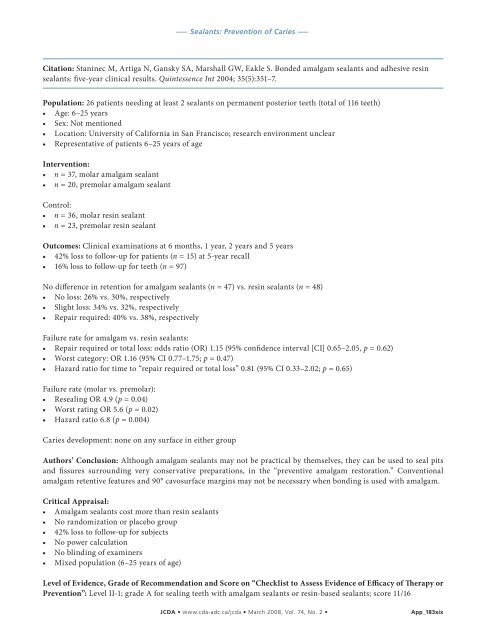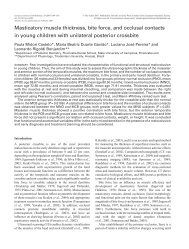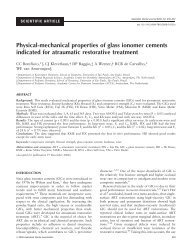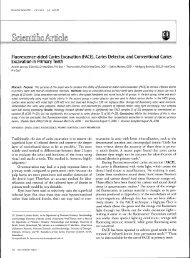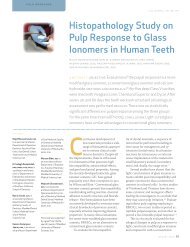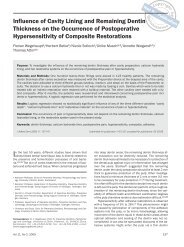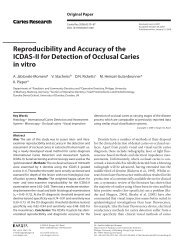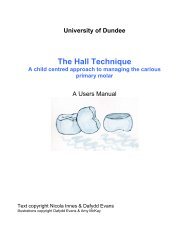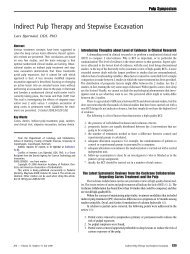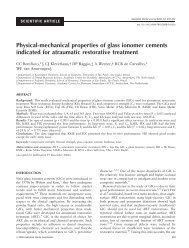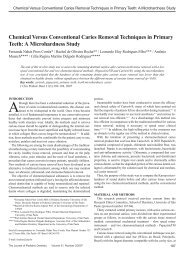Pit and Fissure Sealants in the Prevention of Dental Caries in ...
Pit and Fissure Sealants in the Prevention of Dental Caries in ...
Pit and Fissure Sealants in the Prevention of Dental Caries in ...
You also want an ePaper? Increase the reach of your titles
YUMPU automatically turns print PDFs into web optimized ePapers that Google loves.
––– <strong>Sealants</strong>: <strong>Prevention</strong> <strong>of</strong> <strong>Caries</strong> –––<br />
Citation: Stan<strong>in</strong>ec M, Artiga N, Gansky SA, Marshall GW, Eakle S. Bonded amalgam sealants <strong>and</strong> adhesive res<strong>in</strong><br />
sealants: five-year cl<strong>in</strong>ical results. Qu<strong>in</strong>tessence Int 2004; 35(5):351–7.<br />
Population: 26 patients need<strong>in</strong>g at least 2 sealants on permanent posterior teeth (total <strong>of</strong> 116 teeth)<br />
• Age: 6–25 years<br />
• Sex: Not mentioned<br />
• Location: University <strong>of</strong> California <strong>in</strong> San Francisco; research environment unclear<br />
• Representative <strong>of</strong> patients 6–25 years <strong>of</strong> age<br />
Intervention:<br />
• n = 37, molar amalgam sealant<br />
• n = 20, premolar amalgam sealant<br />
Control:<br />
• n = 36, molar res<strong>in</strong> sealant<br />
• n = 23, premolar res<strong>in</strong> sealant<br />
Outcomes: Cl<strong>in</strong>ical exam<strong>in</strong>ations at 6 months, 1 year, 2 years <strong>and</strong> 5 years<br />
• 42% loss to follow-up for patients (n = 15) at 5-year recall<br />
• 16% loss to follow-up for teeth (n = 97)<br />
No difference <strong>in</strong> retention for amalgam sealants (n = 47) vs. res<strong>in</strong> sealants (n = 48)<br />
• No loss: 26% vs. 30%, respectively<br />
• Slight loss: 34% vs. 32%, respectively<br />
• Repair required: 40% vs. 38%, respectively<br />
Failure rate for amalgam vs. res<strong>in</strong> sealants:<br />
• Repair required or total loss: odds ratio (OR) 1.15 (95% confidence <strong>in</strong>terval [CI] 0.65–2.05, p = 0.62)<br />
• Worst category: OR 1.16 (95% CI 0.77–1.75; p = 0.47)<br />
• Hazard ratio for time to “repair required or total loss” 0.81 (95% CI 0.33–2.02; p = 0.65)<br />
Failure rate (molar vs. premolar):<br />
• Reseal<strong>in</strong>g OR 4.9 (p = 0.04)<br />
• Worst rat<strong>in</strong>g OR 5.6 (p = 0.02)<br />
• Hazard ratio 6.8 (p = 0.004)<br />
<strong>Caries</strong> development: none on any surface <strong>in</strong> ei<strong>the</strong>r group<br />
Authors’ Conclusion: Although amalgam sealants may not be practical by <strong>the</strong>mselves, <strong>the</strong>y can be used to seal pits<br />
<strong>and</strong> fissures surround<strong>in</strong>g very conservative preparations, <strong>in</strong> <strong>the</strong> “preventive amalgam restoration.” Conventional<br />
amalgam retentive features <strong>and</strong> 90° cavosurface marg<strong>in</strong>s may not be necessary when bond<strong>in</strong>g is used with amalgam.<br />
Critical Appraisal:<br />
• Amalgam sealants cost more than res<strong>in</strong> sealants<br />
• No r<strong>and</strong>omization or placebo group<br />
• 42% loss to follow-up for subjects<br />
• No power calculation<br />
• No bl<strong>in</strong>d<strong>in</strong>g <strong>of</strong> exam<strong>in</strong>ers<br />
• Mixed population (6–25 years <strong>of</strong> age)<br />
Level <strong>of</strong> Evidence, Grade <strong>of</strong> Recommendation <strong>and</strong> Score on “Checklist to Assess Evidence <strong>of</strong> Efficacy <strong>of</strong> Therapy or<br />
<strong>Prevention</strong>”: Level II-1; grade A for seal<strong>in</strong>g teeth with amalgam sealants or res<strong>in</strong>-based sealants; score 11/16<br />
JCDA • www.cda-adc.ca/jcda • March 2008, Vol. 74, No. 2 • App_183xix


